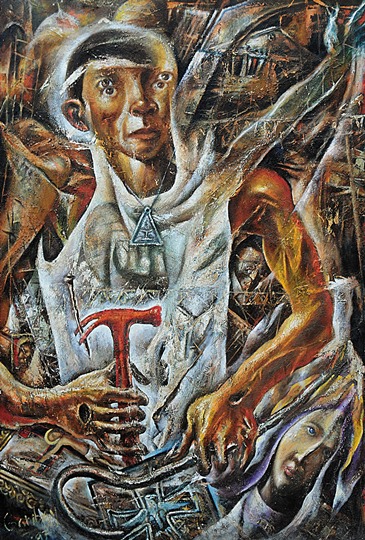Garibay, Emmanuel - VM - Rod Pattenden
Emmanuel Garibay: Bathala

Finding Christ in Asia: The Great Disrupter
By Rod Pattenden
Striding out of the picture plane, this figure of Christ seems to rip through the surface of the work, hammer and crowbar in hand ready to disrupt the very order of things. No gentle saviour or calm man of peace who would be at home in the churches of the middle class, this figure concentrates his gaze on some point situated in the world of the viewer. He is striding with urgency towards an appointment with the future. Two sets of eyes, one fixed perhaps on the viewer, the other on this moment of decision and disruption. This Christ is the Liberator, disturber, prophet and builder. He has in one hand a hammer to build, the other the crowbar to pull apart. This is a figure of fierce passion and decisive action, an unstable, unpredictable force for renewal, the iconoclast, a breaker of images, with eyes on the emerging signs of justice and compassion.
This is the work of Filipino artist Emmanuel Garibay, an artist who has received wide recognition in his native country for his challenging and moving realist images of Filipino society. He is a person of great warmth with a steely eye for injustice and pompous self-righteousness. In a country that is mainly Christian, he scrutinises the conventions and comfortable icons of his culture to shake out the new possibilities of hope and renewal. His works are often funny, ironic, full of curiosity and compassion. They often represent the poor in dignified roles, while upending those in power who are too familiar with their social prestige and the trappings of position. When he turns to religious imagery he is particularly sharp and incisive. This Christ is not a light skinned person of European origin, which is the manner in which the Spanish depicted the figure during the 400 years of colonial rule. Nor does he fit the glossy expectations of TV evangelists and modern day miracle workers that have arrived through American pop culture. This Bathala – who is the Creator of the Tagalog People – is an indigenous Christ who arises within the culture as a force for hope and liberation.
The European colonialisation of the Philippines stands out in contrast to most other countries in Asia. While the rest of the region has maintained distinctive indigenous cultures and religious expression, mainly through Buddhism, the Philippines has been subject to over 400 years of European colonisation. From 1540 the Spanish ruled this chain of over 700 islands, linked closely through trade and cultural ties with their Latin American colonies in Mexico and Cuba. Next, in 1898, the USA annexed the country as part of their colonial expansion. The country only found its independence in 1945 after the Second World War and now boasts a population of over 100 million people. It is a country with a split personality, where the tourist brochures proclaim the citizens as the happiest people on earth, while its inhabitants continue to live under a colonial imagination, held captive by corruption and the forces of globalisation.
Emmanuel Garibay through his lively and expressive works provides a sympathetic window into this complex yet wonderful country. He also gives insights into the complex problems of colonisation and the challenge of seeing things as they really are. Garibay's search for an Asian or indigenous Christ figure is at the centre of his work. In that search he draws attention to the nature of our situation where we are often blind to the truth of things, because we are ‘cultured’, because we see things as natural and self-evident when in fact they are mediated to us by our context. Simply put – is the image of Christ a European one – fair-haired and blue eyed – or even perhaps a Middle Eastern one, darker skin with curly dark beard? Garibay peels off the skin that sticks to our eyes to realise how conditioned we have been to the figure of Christ, who is at home within our culture and rendered as a safe citizen who obeys the laws. This familiar Christ is rather ineffective and finds no vocation as a prophet within our world. The work Bathala renders the Christ as a disruptor of culture. It is representative of Garibay’s tendency in all his work to wake us up to our blindness, and to awaken a Christ set free from stereotypes, churchly piety and good manners, who in turn may upend the order of things towards a more just and humane world.
*******
Emmanuel Garibay: Bathala, 1997, oil on canvas, 183 x 137 cm, collection of the artist.
Emmanuel Garibay is an important artist from the Philippines who has gained wide recognition in his own country for his social realist painting and drawings. His works have been exhibited in Australia, Europe and North America. His work has also been widely reproduced through many publications around the world as they explore issues of justice and the search for Christ in Asia. In 2011 the Overseas Ministries Study Centre (OMSC) published a 72-page book Where God Is: The Paintings of Emmanuel Garibay, which provides a useful full colour survey of his work. Emmanuel Garibay maintains a website that surveys his practice.
Rev Dr Rod Pattenden is an art historian and curator from Newcastle, Australia. He has written widely about art and religion in Australia, Asia and the Pacific. He is also actively involved in exploring the relationships between faith, spirituality and the creative arts. He is minister of the Adamstown Uniting Church, in Newcastle. http://www.rodpattenden.id.au/
ArtWay Visual Meditation October 30, 2016






